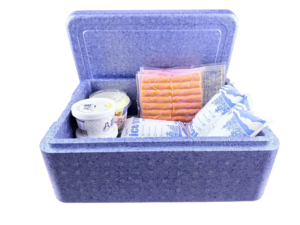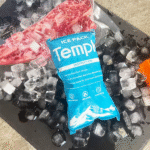Optimale Praktiken bei der Lagerung & Transport temperaturempfindlicher Medikamente
Die Lagerung und der Transport temperaturempfindlicher Medikamente sind entscheidende Elemente in der Pharma- und Gesundheitsbranche. Diese Medikamente, einschließlich Impfstoffe, Insulin, Biologika, und andere biologisch aktive Medikamente, Muss während ihres gesamten Lebenszyklus bestimmte Temperaturbereiche aufrechterhalten, um ihre Sicherheit zu gewährleisten, Wirksamkeit, und Integrität. Alle Abweichungen von diesen erforderlichen Temperaturen können zu beeinträchtigen Produkten führen, Risiken für die Gesundheit des Patienten und die Wirksamkeit der Behandlung darstellen.

Die Bedeutung der Temperaturkontrolle verstehen
Temperaturempfindliche Medikamente fallen typischerweise in zwei Kategorien: diejenigen, die Kühlung benötigen (2° C bis 8 ° C.) und diejenigen, die gefrierende Temperaturen benötigen (unter -20 ° C oder sogar niedriger). Produkte in diesen Kategorien sind sehr anfällig für Temperaturschwankungen, was zu einer Verschlechterung führen kann, Reduzierte Potenz, oder sogar vollständige Unwirksamkeit. Zum Beispiel, Impfstoffe können ihre Immunogenität verlieren, wenn sie höhere Temperaturen ausgesetzt sind, Während Insulin weniger effektiv werden kann, wenn nicht cool gehalten wird.
Schlüsselfaktoren bei der temperaturkontrollierten Lagerung
-
Richtige Lagerbedingungen
Alle temperaturempfindlichen Medikamente sollten in einer kontrollierten Umgebung gelagert werden, die kontinuierlich überwacht wird. Temperaturgesteuerte Lagereinheiten, wie Kühlschränke und Gefriergeräte, müssen mit zuverlässigen Temperaturüberwachungssystemen ausgestattet sein. Diese Systeme warnen das Personal bei Abweichungen vom eingestellten Temperaturbereich, Sicherstellen, dass Korrekturmaßnahmen sofort ergriffen werden können. -
Sichere Speicherorte
Medikamente sollten an den dafür vorgesehenen Stellen aufbewahrt werden, sichere Bereiche, die keinen Umweltschwankungen unterliegen. Der Lagerbereich sollte sauber und organisiert gehalten werden, um Lichteinwirkung oder Verunreinigungen vorzubeugen, was die Qualität des Medikaments weiter beeinträchtigen könnte. -
Minimierung des Zugriffs
Der Zugang zu temperaturempfindlichen Lagern sollte nur autorisiertem Personal vorbehalten sein. Durch häufiges Öffnen von Lagerschränken kann warme Luft eindringen, Dies kann die Temperatur im Inneren destabilisieren und zu möglichen Schäden an den Produkten führen. daher, Die Anzahl der Türöffnungen sollte minimiert werden.
Best Practices beim Transport temperaturempfindlicher Medikamente
-
Kaltkettenverpackung
Verpackungen spielen eine wichtige Rolle beim Schutz temperaturempfindlicher Medikamente während des Transports. Die Verwendung hochwertiger Isolierverpackungen, wie Isolierboxen und Taschen, Hilft, die Innentemperatur während des Transports aufrechtzuerhalten. Einige Verpackungslösungen sind mit Temperaturindikatoren oder Datenloggern ausgestattet, die Temperaturverhältnisse in Echtzeit aufzeichnen und überwachen, Bereitstellung wertvoller Informationen darüber, wie das Produkt Temperaturschwankungen ausgesetzt ist. -
Verwendung von Eisbeuteln und Gelpackungen
Um die richtige Temperatur aufrechtzuerhalten, verschiedene Kühlmittel, wie Eisbeutel oder Gelpackungen, werden in Verbindung mit Isolierbehältern verwendet. Diese Kühlmittel nehmen Wärme aus der Umgebung auf und geben sie langsam ab, Halten Sie das Medikament über längere Zeiträume im erforderlichen Temperaturbereich. Der richtige Kühlmitteltyp sollte auf der Grundlage der spezifischen Temperaturanforderungen des Produkts ausgewählt werden. -
Überwachung der Temperatur während des Transports
Eine kontinuierliche Temperaturüberwachung ist unerlässlich, um die Bedingungen zu verfolgen, denen die Medikamente während ihrer Reise ausgesetzt sind. Viele moderne Lösungen beinhalten den Einsatz von Temperaturdatenloggern, das in die Verpackung gelegt werden kann, um die Temperatur über die Zeit aufzuzeichnen. Diese Logger können dann heruntergeladen werden, um zu beurteilen, ob die Produkte zu irgendeinem Zeitpunkt während des Transports unsicheren Temperaturen ausgesetzt waren. -
Auswahl zuverlässiger Transportpartner
Die Zusammenarbeit mit einem Logistikdienstleister mit Erfahrung im Bereich temperaturgeführter Transporte ist von entscheidender Bedeutung. Diese Logistikpartner müssen in der Lage sein, sicherzustellen, dass Fahrzeuge zum Transport temperaturempfindlicher Medikamente mit Kühl- oder Gefriergeräten ausgestattet sind und regelmäßig gewartet werden. Zusätzlich, Fahrer sollten geschult werden, um zu verstehen, wie wichtig es ist, während des Transports die richtige Temperatur aufrechtzuerhalten.
Risikomanagement und Notfallprotokolle
Auch bei bester Vorbereitung, Es kann zu unerwarteten Zwischenfällen kommen, und es kann dennoch zu Temperaturschwankungen kommen. Es ist wichtig, einen Notfallplan für den Umgang mit solchen Situationen zu haben. Einige Schritte zur Risikominderung umfassen::
-
Warnungen zur Temperaturüberwachung: Die Temperaturüberwachung in Echtzeit ermöglicht sofortige Korrekturmaßnahmen, wenn die Temperatur den akzeptablen Bereich verlässt. Es können Alarme eingestellt werden, um das zuständige Personal zu benachrichtigen, damit die notwendigen Schritte eingeleitet werden können, bevor ein Schaden entsteht.
-
Notfallreaktion: Im Falle eines Temperaturverstoßes während des Transports, Es ist von entscheidender Bedeutung, einen Notfallplan zu haben. Dieser Plan kann die Umleitung von Sendungen beinhalten, Verwendung eines Notfall-Backup-Kühlspeichers, oder sogar die Rücksendung von Produkten an das Lager zur ordnungsgemäßen Neubewertung.
Abschluss
Die Lagerung und der Transport temperaturempfindlicher Medikamente sind für die Aufrechterhaltung ihrer Integrität und Wirksamkeit von entscheidender Bedeutung. Durch die Befolgung optimaler Vorgehensweisen – etwa der richtigen Lagerung, zuverlässige Verpackung, Temperaturüberwachung, und die Wahl vertrauenswürdiger Logistikdienstleister – Gesundheits- und Pharmaunternehmen können das Risiko einer Produktverschlechterung verringern und sicherstellen, dass Patienten sicher versorgt werden, wirksame Medikamente. Bei der Aufrechterhaltung einer robusten Kühlkette während des gesamten Prozesses geht es nicht nur um die Einhaltung von Vorschriften, sondern auch darum, das Wohlergehen der Menschen zu gewährleisten, die auf diese lebensrettenden Medikamente angewiesen sind.

























